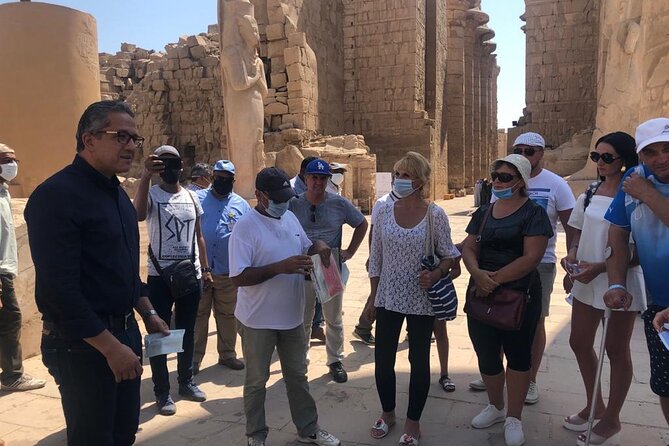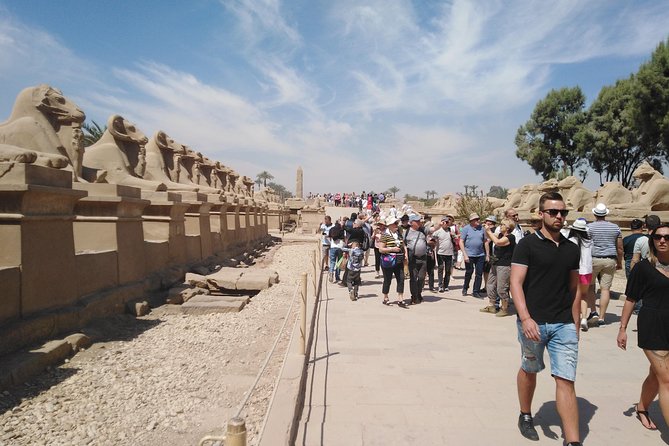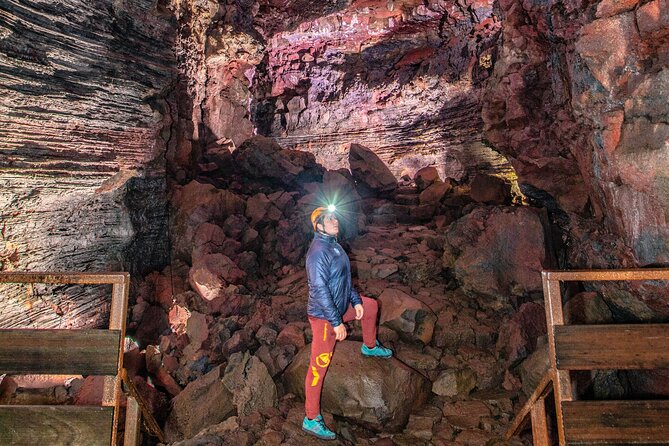Luxor, the ancient Egyptian capital, beckons travelers from Hurghada with its captivating one-day excursion. Visitors can explore the grandeur of the Karnak Temple, an architectural marvel with towering columns and intricate carvings. Beyond this, the iconic Statues of Memnon and the magnificent Temple of Queen Hatshepsut await, each offering a unique glimpse into the rich history and beliefs of the pharaohs. For those eager to uncover the secrets of the past, the Valley of the Kings presents an unparalleled opportunity to explore the well-preserved tombs and treasures that have captivated the world for centuries.
Key Points

- Take a day trip from Hurghada to Luxor to explore the city’s renowned ancient wonders, including the Karnak Temple, Statues of Memnon, and Valley of the Kings.
- Visit the majestic Karnak Temple, a colossal religious complex with a massive Hypostyle Hall and intricate reliefs, obelisks, and sphinx-lined avenues.
- Marvel at the towering Statues of Memnon, iconic landmarks that once guarded the entryway to Amenhotep III’s mortuary temple.
- Discover the architectural grandeur of the Temple of Queen Hatshepsut, a terraced structure commissioned by the female pharaoh Hatshepsut.
- Explore the Valley of the Kings, the necropolis that houses the tombs of pharaohs from the 18th to 20th dynasties, including the option to visit Tutankhamun’s tomb.
Exploring Luxor’s Ancient Wonders

Travelers embark on a journey through the captivating ancient wonders of Luxor, delving into the rich history and breathtaking monuments that have stood the test of time.
The tour takes them to the magnificent Karnak Temple, a colossal religious complex that showcases the grandeur of ancient Egyptian architecture. They’ll also visit the iconic Statues of Memnon, towering sentinels guarding the ruins of the mortuary temple of Amenhotep III.
The highlight of the day is the Valley of the Kings, where they’ll explore the tombs of pharaohs, including the renowned Tutankhamun.
The Temple of Queen Hatshepsut, a stunning architectural masterpiece, completes this immersive exploration of Luxor’s ancient treasures.
Karnak Temple: A Majestic Masterpiece

The Karnak Temple stands as a majestic masterpiece, a colossal religious complex that overwhelms visitors with its sheer scale and architectural grandeur.
This ancient Egyptian temple, located on the east bank of the Nile River in Luxor, was built and expanded over a remarkable period of 2,000 years.
Visitors are awed by the massive Hypostyle Hall, with its 134 towering columns that seem to reach for the sky.
The temple’s intricate reliefs, obelisks, and sphinx-lined avenues offer a glimpse into the fascinating world of ancient Egyptian spirituality and power.
As the crown jewel of the tour, Karnak Temple captivates visitors with its timeless beauty and rich historical significance.
Statues of Memnon: Iconic Landmarks
Towering in solitude on the Nile’s west bank, the colossal Statues of Memnon have long captivated visitors to Luxor, their enigmatic visages bearing witness to the passage of millennia.
These massive stone figures, each standing 60 feet high, once guarded the entryway to the mortuary temple of Amenhotep III. Though the temple itself has largely vanished, the twin Memnon colossi remain, their serene expressions and sheer size inspiring awe in all who behold them.
Over the centuries, the statues have weathered the elements, with one even developing a distinctive crack after being damaged by an earthquake. Yet, they continue to stand as iconic landmarks, reminders of Egypt’s glorious past.
Temple of Queen Hatsheput: Architectural Grandeur
Nestled into the cliffs of Deir el-Bahari, the Temple of Queen Hatshepsut stands as a testament to ancient Egypt’s architectural prowess, its grand and symmetrical design captivating all who lay eyes upon it.
Commissioned by the female pharaoh herself, this majestic temple boasts a terraced structure, with three massive stone terraces leading up to the main sanctuary.
The temple’s intricate relief carvings and hieroglyphic inscriptions offer a glimpse into the prosperous reign of Queen Hatshepsut, who sought to solidify her legacy through this architectural masterpiece.
Visitors are awed by the temple’s sheer scale and the ingenuity of its construction, leaving with a deeper appreciation for the engineering feats of ancient Egypt.
Valley of the Kings: Unparalleled Tombs
Situated on the west bank of the Nile River, the Valley of the Kings is an unparalleled necropolis that captivates visitors with its trove of remarkably preserved royal tombs.
Pharaohs from the 18th to 20th dynasties chose this arid, secluded valley as their final resting place, leaving behind a remarkable legacy of funerary architecture and artwork.
Entering these tombs is like stepping back in time, with vibrant wall paintings, detailed hieroglyphics, and well-preserved sarcophagi revealing the elaborate burial rituals and beliefs of ancient Egypt.
The highlight for many is the opportunity to visit the tomb of the famous boy king, Tutankhamun, whose intact tomb and treasures continue to fascinate the world.
Tutankhamun’s Tomb: An Optional Highlight
Visitors to the Valley of the Kings can choose to add an optional visit to the tomb of the legendary Tutankhamun, whose astonishing treasures continue to captivate the world.
Discovered in 1922, Tutankhamun’s tomb is renowned for its wealth of artifacts and well-preserved state.
Though an extra ticket is required, many travelers choose to include this highlight on their Luxor tour. Guests will have the chance to step inside the pharaoh’s burial chamber and marvel at the intricate wall decorations and iconic golden mask.
With this optional addition, guests can delve deeper into Egypt’s rich history and uncover the secrets of one of the most famous archaeological finds of the 20th century.
Inclusions and Exclusions: What to Expect
The tour package includes an air-conditioned vehicle, entrance tickets to the visited sites, and a lunch meal. However, alcoholic beverages, additional drink purchases, and the extra ticket for Tutankhamun’s tomb aren’t covered in the cost.
Travelers should also account for gratuities and any optional Nile cruises or visits to Banana Island.
The tour provides transportation from Hurghada hotels, with an additional fee for guests from El Gouna, Sahl Hasheesh, and Soma Bay.
While the tour isn’t wheelchair accessible, it’s stroller-friendly. Infants must sit on laps, and the tour isn’t recommended for travelers with back problems.
Group sizes are limited to a maximum of 40 participants.
Booking and Logistics: Important Details
Booking the Luxor One Day Trip from Hurghada is straightforward, with confirmation provided at the time of booking. Travelers can arrange the tour with various tour operators, who’ll pick them up from their Hurghada hotels. Those staying in El Gouna, Sahl Hasheesh, or Soma Bay, however, will incur an additional $15 transfer fee.
The tour is not wheelchair accessible but is stroller accessible. Infants must sit on laps, and it’s not recommended for those with back problems. The maximum group size is 40 travelers. Cancellation is allowed with a full refund if done at least 24 hours before the experience.
| Booking Details | Information |
|---|---|
| Pick-up | From any hotel in Hurghada |
| Additional Transfer Fee | $15 for El Gouna, Sahl Hasheesh, and Soma Bay hotels |
| Cancellation Policy | Full refund if canceled at least 24 hours before the experience |
Frequently Asked Questions
What Is the Dress Code for the Tour?
The tour has a casual dress code. Comfortable, lightweight clothing and closed-toe walking shoes are recommended. Visitors should avoid wearing revealing or overly casual attire out of respect for the cultural and religious sites visited.
Can I Bring My Own Food and Drinks?
Guests can bring their own snacks and non-alcoholic beverages on the tour. However, a lunch is provided as part of the tour package, so bringing a full meal may not be necessary.
Are There Any Restrooms Along the Tour Route?
Yes, there are restrooms available at the major archaeological sites visited during the tour. Visitors can use the restroom facilities provided at Karnak Temple, the Valley of the Kings, and other stops along the tour route.
Can I Take Photos Inside the Tombs and Temples?
Visitors can generally take photos inside the tombs and temples, but some restrictions may apply. It’s best to check with the tour guide or local authorities for specific rules and guidelines regarding photography during the tour.
Is It Safe to Visit Luxor During the Summer?
Visiting Luxor during the summer is generally safe, though the hot weather can be challenging. Travelers should stay hydrated, wear lightweight clothing, and take breaks in air-conditioned spaces to beat the heat. With proper preparation, the ancient wonders of Luxor can be explored comfortably.
Recap
Luxor’s ancient wonders offer a captivating one-day excursion from Hurghada. Visitors can explore the majestic Karnak Temple, iconic Statues of Memnon, and the architectural grandeur of the Temple of Queen Hatshepsut.
The renowned Valley of the Kings, with its pharaohs’ tombs, provides a unique insight into ancient Egypt’s rich history. An optional visit to Tutankhamun’s tomb adds to the fascination of this exceptional day trip.






